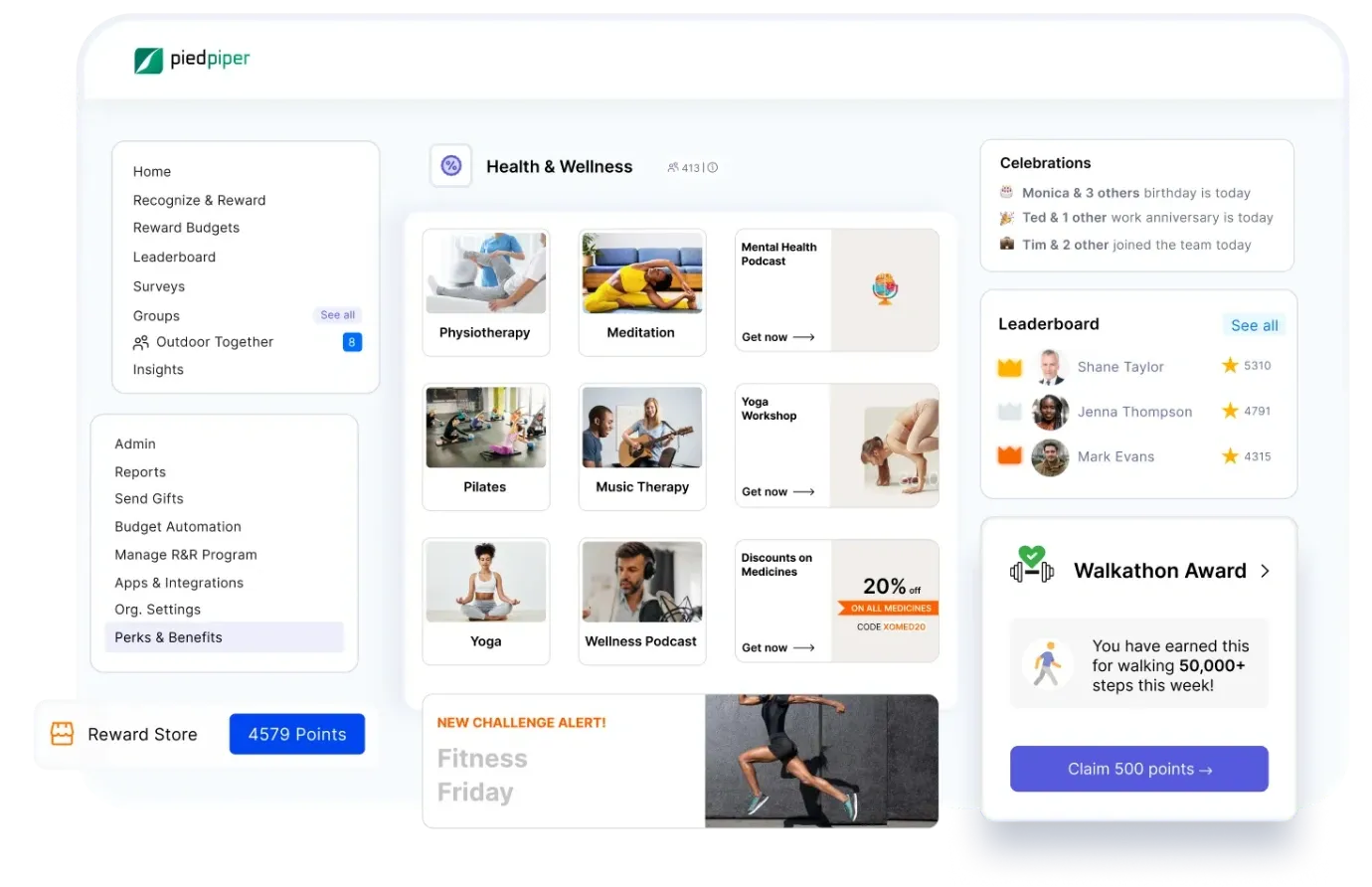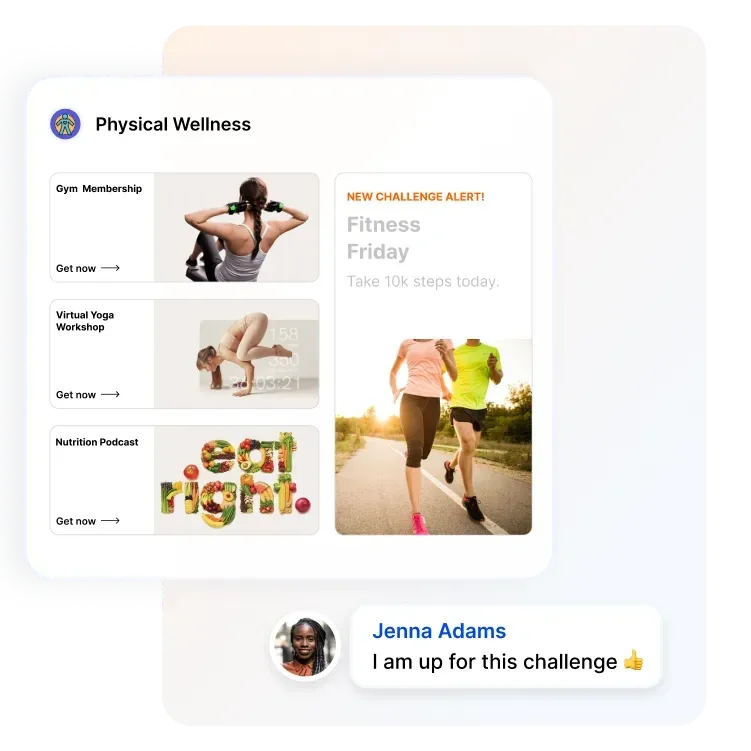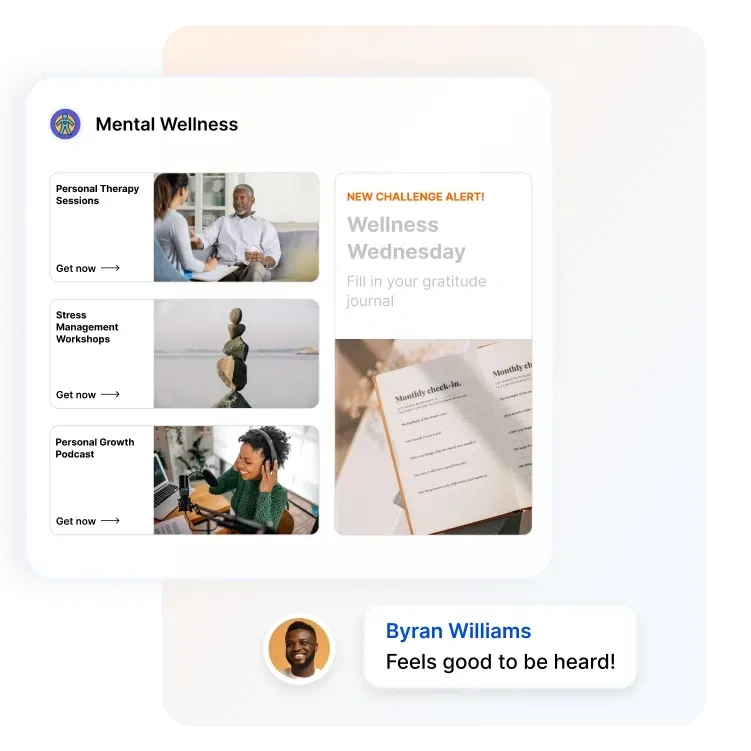The Ultimate Guide to Building an Effective Employee Wellbeing Program
An employee wellbeing program enhances productivity, engagement, and retention. Learn how to create a workplace culture that prioritizes employee well-being and success.
Auf dieser Seite
- Understanding employee wellbeing programs
- Die Vorteile von Programmen für das Wohlbefinden der Mitarbeiter
- Faktoren, die das Wohlbefinden der Mitarbeiter beeinflussen
- Wie kann man ein Programm zum Wohlbefinden am Arbeitsplatz nicht einführen?
- Then how do you create effective employee wellbeing programs?
- Top 8 employee wellbeing programs to implement in 2025
- How Empuls enhances employee wellbeing programs
- Schlussfolgerung
Jedes Unternehmen möchte, dass seine Mitarbeiter glücklich und gesund sind. Deshalb machen sich heutzutage so viele kleine Unternehmen und große Konzerne Gedanken darüber, wie sie zur Gesundheit und zum Wohlbefinden ihrer Mitarbeiter beitragen können.
Since people spend so much of their lives at work, this is a very vital concern for employers.
Und die Förderung der psychischen Gesundheit und des Wohlbefindens der Mitarbeiter am Arbeitsplatz ist nicht nur etwas, das sich gut anfühlt, sondern auch für viele Bereiche Ihres Unternehmens von Vorteil ist.
So if you want to keep your best employees and help them do great work, you need to focus on improving employee well-being. But let’s be honest - there are plenty of poorly designed health and wellbeing programs for employees out there.
Wie können Sie also sicher sein, dass Sie ein Programm auf die Beine stellen, für das Ihnen Ihre Mitarbeiter tatsächlich danken werden? Schließlich funktionieren Programme zum Wohlbefinden am Arbeitsplatz nur dann gut, wenn die Mitarbeiter häufig und mit Begeisterung daran teilnehmen.
Kein Grund zur Sorge - wir helfen Ihnen bei der Erstellung eines Wohlfühlprogramms, das Ihre Mitarbeiter lieben werden.
Fangen wir an!
Understanding employee wellbeing programs
Employee wellbeing programs focus on improving the physical health of employees at your company.
Sie sehen in jedem Unternehmen ein wenig anders aus, aber viele von ihnen bieten Programme zur Raucherentwöhnung, Ermäßigungen für die Mitgliedschaft im Fitnessstudio, gesunde Büro-Snacks, Step-Wettbewerbe und vieles mehr.
Many wellbeing programs are also now beginning to focus on mental health as well as physical. By implementing programs like EAP (Employee Assistance Programs), stress reduction programs, meditation programs, and more.
Es geht darum, die Gesundheit der Mitarbeiter zu verbessern, indem man ihnen einen gesunden Lebensstil leichter und kostengünstiger ermöglicht.
Die Vorteile von Programmen für das Wohlbefinden der Mitarbeiter
Warum investieren Arbeitgeber in diese Programme? Sie können ziemlich kostspielig sein, je nachdem, für welche Programme sich Ihr Unternehmen entscheidet.
Aber trotz der Kosten und des Aufwands, der für ihre Umsetzung erforderlich ist, sind sie oft sehr effektiv und rentieren sich sehr.
Denn glückliche, gesunde Mitarbeiter sind viel produktiver und engagierter als müde, gestresste, besorgte oder kranke Mitarbeiter.
Grundsätzlich bedeutet die Gesunderhaltung der Mitarbeiter, dass sie nicht so oft zur Arbeit fehlen, und das ist natürlich gut für den Erfolg Ihres Unternehmens. Außerdem bedeuten die rasant steigenden Gesundheitskosten in Ländern wie den USA, dass kranke Mitarbeiter eine enorme Belastung für die Unternehmensressourcen darstellen können.
Um produktiv und engagiert zu sein, müssen die Mitarbeiter aber auch weniger Sorgen und Stress in ihrem Leben haben, und viele fortschrittlichere Programme für das Wohlbefinden der Mitarbeiter gehen auch darauf ein.
The World Health Organization says that mental illness is now the leading cause of disability and illness. High levels of chronic stress caused by unhealthy workplace cultures have a real impact on employee engagement and productivity.
No one does their best work when surrounded by stressful conditions. But as sad as that sounds, well-designed employee health and wellness programs can help alleviate many of those problems.
Ihre Mitarbeiter werden nicht nur gesünder und produktiver sein, sondern sie werden sich auch unterstützt fühlen und glücklicher sein, in einem Unternehmen zu arbeiten, das sich so fürsorglich um sie kümmert. Das bedeutet auch weniger Fluktuation und höhere Arbeitszufriedenheit!
Faktoren, die das Wohlbefinden der Mitarbeiter beeinflussen
Es gibt drei wesentliche Faktoren, die die Gesundheit und das Wohlbefinden der Mitarbeiter am Arbeitsplatz steigern. Wir werden sie heute ausführlich behandeln, damit Sie genau wissen, was Sie tun müssen, um glücklichere, gesündere und produktivere Mitarbeiter zu haben.
1. Auftragskontrolle
One of the biggest factors in employee well-being (and employee engagement) is their discretion over what they do and how they do it. That’s the basis of job control.
Limited job control is linked strongly with poorer physical health, including higher death rates, heart disease, and diabetes.
Auch die Kontrolle am Arbeitsplatz ist ein wichtiger Faktor für die psychische Gesundheit. Mehrere Studien haben ergeben, dass Menschen mit einem höheren Maß an Arbeitsplatzkontrolle weniger Angstzustände und Depressionen haben.
Diese Ergebnisse bedeuten, dass Arbeitnehmer in höheren Positionen, obwohl sie tendenziell stressigere Aufgaben erledigen, mehr Verantwortung tragen und oft lange arbeiten, weniger negative Auswirkungen auf ihre Gesundheit haben, weil sie ihre Arbeit besser kontrollieren können.
It might seem fairly challenging to increase job control for lower-level workers who are mostly responsible for repetitive, boring tasks where they lack control. But it just takes some imagination to look at a new way to increase job control.
For example, reducing the amount of micromanaging that leaders and managers do is a great first step. While managers certainly need to manage their people, getting too into the details and controlling employees is unhelpful for everyone.
If you’re hiring the right people, you really should be letting them do the jobs they were hired to do with the skills they have and not watching their every move. And even workers infamously tightly controlled phone lines can be given additional autonomy with some creative thinking.
Collective Health empowered its “patient advocates” who answer phones to solve complex patient problems to solve problems on the floor as they come up, instead of giving them a strict script.
This has increased employee retention, satisfaction, and motivation. And it’s proved more efficient at solving customer problems as well - everybody benefits.
2. Motivating employees
Job control doesn’t just affect physical and mental health - it also has a strong impact on how motivated and engaged employees are in their jobs. When employees work in an environment where they don’t have much control over their work or how they get it done, it creates stress and uncertainty.
Sie könnten gezwungen sein, unwirksame oder veraltete Verfahren zu befolgen, und dann für schlechte Ergebnisse bestraft werden, oder es werden ihnen Ziele gesetzt, die in ihrer Rolle unmöglich zu erreichen sind.
Wenn dies der Fall ist, ist es für jeden Mitarbeiter schwer, sich weiterhin zu engagieren und über sich hinauszuwachsen. Wenn man nicht das Gefühl hat, dass man für seine Aufgaben verantwortlich ist, sinken Kompetenz und Leistung.
That’s not a workplace that encourages you to try your best because it probably won’t be recognized or rewarded if you do. Low job control makes workplaces feel chaotic and unpredictable - you don’t have control over your role or tasks, so it’s hard to predict your actions' outcomes. That is a pretty significant demotivator for most employees.
3. Social support
Freunde und ein starkes soziales Netz zu haben, ist sehr förderlich für die Gesundheit und hilft, Stress abzubauen, auch am Arbeitsplatz. Aber in vielen Unternehmen nimmt das Leben am Arbeitsplatz tatsächlich die Gefühle sozialer Unterstützung und Verbundenheit ab.
Klingt das überraschend? Das ist es nicht, wenn man das Umfeld in vielen Spitzenunternehmen betrachtet. An vielen Arbeitsplätzen gibt es Leistungsmessungen, bei denen die Mitarbeiter gegeneinander ausgespielt werden - wie z. B. erzwungene Kurveneinstufungen oder Beförderungssysteme. In jedem Beurteilungszyklus kommt nur eine bestimmte Anzahl von Mitarbeitern in Frage.
Andere Unternehmen behandeln ihre Mitarbeiter wie in einer reinen Transaktionsbeziehung, in der Arbeit nur gegen Geld getauscht wird.
4. The right employee wellbeing framework
Wenn die meisten Arbeitgeber an ein Programm zur Förderung des Wohlbefindens ihrer Mitarbeiter denken, konzentrieren sie sich darauf, die Mitarbeiter dazu zu bringen, von sich aus gesündere Verhaltensweisen an den Tag zu legen. Das könnte bedeuten, mit dem Rauchen aufzuhören, weniger zu trinken, mehr Sport zu treiben oder sich gesünder zu ernähren.
Arbeitgeber richten diese Programme in der Regel nicht ein, um die Bedürfnisse ihrer Mitarbeiter zu erfüllen, sondern um ihre eigenen Gesundheitskosten zu senken. Das ist der falsche Rahmen für das Wohlbefinden der Mitarbeiter.
The drivers of unhappy and unhealthy employees are more often factors in the control of employers - unfair workplace practices, unmanageable workloads, lack of role clarity, poor communication, and not enough time to get work done.
Mehr Bewegung und Meditation können zwar die Stresssymptome verringern, aber wenn Ihr Programm für das Wohlbefinden der Mitarbeiter nicht die eigentlichen Ursachen des Stresses angeht, werden Sie das Problem nicht mit einem Rabatt für ein Fitnessstudio lösen.
Eine vernünftige Arbeitsbelastung und ein Gefühl der Fairness am Arbeitsplatz tragen wesentlich dazu bei, die stressbedingten Gesundheitskosten zu senken.
Auch Arbeitnehmer wollen mehr als nur einen Rabatt für ein Fitnessstudio, um etwas für ihre Gesundheit zu tun - vor allem, wenn sie zu müde oder ausgebrannt von der Arbeit sind, um jeden Tag ins Fitnessstudio zu gehen.
5. Improving employee wellbeing
Das Wohlbefinden der Mitarbeiter ist mehr als nur ein Nice-to-have. Es ist entscheidend für die Gesundheit der Menschen, die für Sie arbeiten, und es ist auch ein positiver Geschäftsfaktor.
Arbeitnehmer, die nicht unter starkem Stress und Burnout am Arbeitsplatz leiden, haben die Kontrolle über ihre Aufgaben und sind durch starke soziale Bindungen am Arbeitsplatz produktiver und engagierter.
Wondering how further to promote that link between employee wellbeing and performance? You can simply ask your employees how they’re regularly feeling to learn how to handle stress at your workplace and what they really want from wellbeing programs. Let’s discuss about employee wellbeing programs.
Wie kann man ein Programm zum Wohlbefinden am Arbeitsplatz nicht einführen?
All diese Vorteile sind möglich, wenn Sie das richtige Wohlfühlprogramm wählen, aber sie verpuffen, wenn Sie das falsche Programm wählen. Was soll das heißen?
Ist nicht alles, was der Gesundheit Ihrer Mitarbeiter dient, eine gute Wahl? Werden sie dafür nicht dankbar sein?
Nun, nicht immer. Wahrscheinlich haben Sie Ihre Arbeit gut gemacht und ein paar wirklich kluge Leute eingestellt - sie werden Bemühungen durchschauen, die Ihrem Unternehmen mehr nutzen als ihnen.
Wenn Ihre Wellness-Programme vor allem darauf abzielen, die Versicherungsprämien zu senken, indem sie die Mitarbeiter für ungesundes Verhalten bestrafen, werden sie nicht glücklich sein - und sie werden nicht so aktiv teilnehmen, wie Sie es sich wünschen würden.
As Deloitte has found, there’s actually often a huge gap between what employers think their people need, and what employees actually want. That’s why doing your research properly is vital before you commit to an expensive and unpopular wellbeing program.
And SHRM notes that focusing exclusively on physical wellness is pretty ineffective for most organizations, so it’s better to think holistically about wellbeing.
Then how do you create effective employee wellbeing programs?
Creating a wellbeing program that truly resonates with employees requires more than good intentions—it demands research, personalization, and employee input. Here’s how to do it right:
1. Start with listening: ask, don’t assume
Instead of making assumptions, directly involve employees in the design process:
- Use surveys to understand what employees value most in wellbeing support.
- Ask about stressors, preferred perks, and areas needing improvement.
Tools like Empuls offer lifecycle, eNPS, and pulse surveys with AI-driven insights to uncover employee needs and track sentiment over time.
2. Identify root causes, not just symptoms
Don’t just encourage healthier habits—address systemic workplace stressors:
- Evaluate workloads, fairness, communication gaps, and leadership quality.
- Prioritize job control, autonomy, and social support, which research shows are core to wellbeing.
- Recognize that burnout isn’t solved with a gym pass—it requires structural fixes.
3. Design holistic, flexible programs
Include a variety of initiatives that support:
- Physical wellness: fitness benefits, step challenges, health screenings.
- Mental wellness: therapy sessions, meditation apps, stress management workshops.
- Financial wellness: salary advance programs, tax-saving perks, early wage access.
- Lifestyle needs remote work support, childcare, and learning allowances.
Empuls offers all of the above via customizable Lifestyle Spending Accounts (LSA) and fringe benefits across 50+ countries.
4. Ensure inclusivity & personalization
Avoid one-size-fits-all approaches. Offer choice and flexibility in benefits—e.g., wellness options, rewards, and discounts that reflect different life stages and preferences.
Empuls enables modular configuration of wellbeing programs based on roles, locations, and demographics.
5. Communicate transparently
Even the best program fails without awareness. Ensure clear communication on what's offered and how to access it.
Use internal communication platforms like Empuls Social Intranet to drive awareness, updates, and engagement.
6. Automate for consistency & scale
Automate key touchpoints like:
- Birthday wishes, service anniversaries, wellness nudges, and rewards
- Personalized milestone recognitions to show continuous care
Empuls supports automated workflows and AI nudges to streamline delivery and ensure no moment is missed.
7. Measure impact & iterate
Track participation, sentiment, and ROI:
- Use analytics dashboards to identify what’s working and what’s not.
- Iterate based on continuous feedback to improve adoption and effectiveness.
Empuls provides real-time reporting and people analytics to measure program performance and engagement levels.
By co-creating programs with employees, aligning with their actual needs, and leveraging platforms like Empuls for automation, insights, and personalization, your wellbeing initiatives will be not only effective—but genuinely appreciated.
Top 8 employee wellbeing programs to implement in 2025
Jetzt, da Sie die Vorteile - und die Fallstricke - von Programmen für das Wohlbefinden der Mitarbeiter kennen, welche sollten Sie tatsächlich in Betracht ziehen?
Hier finden Sie einige der besten Wohlfühlprogramme, für deren Umsetzung Ihnen Ihre Mitarbeiter dankbar sein werden. Dies sind nicht nur unsere Ideen - sie beruhen auf den Wünschen der Mitarbeiter auf der ganzen Welt (aber vergessen Sie nicht, auch Ihre eigenen Mitarbeiter zu befragen!).
1. Flexible work schedules
Das mag Ihnen vielleicht nicht als Wohlfühlvorteil erscheinen - aber tatsächlich sind Mitarbeiter glücklicher und gesünder, wenn sie mehr Kontrolle darüber haben, wo und wann sie arbeiten.
With so many options for designing flexible work schedules that work for your business, you can provide flexibility and autonomy for your employees so they better balance their work and life together. In fact, Harvard Business Review says that employees thrive when they’re offered these options.
2. Healthy office snacks
Viele Arbeitgeber glauben, dass sie ihren Mitarbeitern einen großen Dienst erweisen, wenn sie ihnen Kekse und Süßigkeiten zum Naschen am Arbeitsplatz anbieten. Das mag zwar kurzfristig befriedigend sein, aber die Mitarbeiter wünschen sich eigentlich mehr gesunde Optionen.
Google provides low-cost healthy snacking options in all of its offices, which employees love. And healthy snacks prevent the mid-afternoon sugar crash from sapping productivity out of your employees too.
3. Wellness counseling
Gesund zu sein und sich wohl zu fühlen, kann in unserer schnelllebigen, von Fastfood geprägten Welt eine Herausforderung sein. Arbeitnehmer, die sich gesund ernähren wollen, wissen vielleicht nicht genau, welche Schritte sie unternehmen sollen.
Aus diesem Grund ist die Wellness-Beratung als Programm für das Wohlbefinden am Arbeitsplatz so beliebt geworden - die Mitarbeiter können sich individuell beraten lassen und erhalten Hilfe, um ein gesünderes Leben nach ihren eigenen Vorstellungen zu führen.
4. Mental health counseling
Hilfe zu bekommen, wenn die psychische Gesundheit leidet, ist vielerorts schwierig. Eine schlechte psychische Gesundheit kann jedoch zu ernsthaften Problemen im Berufs- und Privatleben führen.
Die Unterstützung Ihrer Mitarbeiter bei der Inanspruchnahme einer psychosozialen Beratung ist nicht nur bei den Mitarbeitern sehr beliebt, sondern auch eine mitfühlende Sache - es ist also eine gute Idee, darüber nachzudenken, wie Sie dies anbieten können.
5. Parental support
Being a working parent is hard for both mothers and fathers. It can be a big challenge to balance work and childcare every day. In fact, US employers lose about $13 billion a year due to lost productivity and earnings due to inadequate childcare.
Das Angebot von Unterstützungsmaßnahmen wie großzügiger bezahlter Elternurlaub, Kinderbetreuungszuschläge, zusätzliche Kinderbetreuungsmöglichkeiten und vieles mehr kann das Leben der Eltern, die bei Ihnen arbeiten, erheblich verbessern, und sie sind in der Regel sehr loyale Mitarbeiter.
6. Destressing programs
Stress am Arbeitsplatz ist ein großes und wachsendes Problem in vielen - vielleicht sogar den meisten - Unternehmen. Selbst wenn Sie erhebliche Anstrengungen unternommen haben, um eine gesunde und unterstützende Arbeitsplatzkultur zu schaffen, kann sich in Stoßzeiten oder bei großen Projekten dennoch Stress einschleichen.
Managing that stress can be hard alone, so implementing programs that help employees learn how to deal with stress can be a big benefit. This could be yoga classes, tai chi, meditation lessons, or other relaxation techniques - Wegman’s offers customized yoga plans for employees, for example.
7. Community involvement
Es ist wahr - Mitarbeiter schätzen es sehr, wenn sie einen Beitrag zu ihrer Gemeinschaft leisten können! Eine bezahlte Freistellung für ehrenamtliche Tätigkeiten oder die Organisation von Freiwilligentagen mit Ihren Teams tragen wesentlich dazu bei, dass sich Ihre Mitarbeiter wohl und unterstützt fühlen.
Plus, it benefits the larger community and the image of your business as well. Liberty Mutual Insurance offers annual days of service called Serve with Liberty, which half of their employees across the globe participate in.
How Empuls enhances employee wellbeing programs

Empuls helps organizations design effective employee wellness programs by addressing both physical and mental well-being. With a data-driven approach, it enables HR teams to build workplace wellbeing programs that employees appreciate and actively engage with.
1. Physical wellness: Supporting a healthier workforce

Empuls promotes employee wellbeing by offering flexible options for physical health, allowing employees to choose what suits them best. From fitness challenges with rewards to gym memberships, virtual yoga classes, and nutrition consultations, employees can access a variety of wellness resources that align with their personal health goals. With Empuls, you get:
- Fitness challenges, gym memberships, and yoga classes
- Mental wellness tools: stress management workshops, therapy sessions, meditation apps
- Flexible fringe benefits: Lifestyle Spending Accounts (LSA) for health, travel, meals, learning
2. Mental wellness: Reducing stress and improving focus

To help employees manage stress, Empuls integrates mental wellness solutions into employee wellbeing programs. Companies can offer personal therapy sessions, stress management workshops, and meditation app subscriptions to help employees improve sleep, breathing, and overall mental resilience.
3. Comprehensive benefits for both employees and employers
For HR teams: Fully customizable to fit company-wide workplace wellbeing programs. Scalable across locations and available on all devices. A robust reporting suite with 24/7 access to data-backed insights and actionable recommendations.
For employees: Holistic support across personal, financial, physical, and mental wellness. Exclusive discounts and extended coverage beyond standard insurance. 24/7 customer support, including multilingual assistance, chat support, and a help center.
By leveraging Empuls’ employee wellness solutions, businesses can create a culture that prioritizes employee wellbeing, enhances engagement, and reduces workplace stress, leading to a happier and more productive workforce. Schedule a call now!
Schlussfolgerung
Creating an effective employee wellbeing program isn’t just a checkbox exercise—it’s a strategic investment in your company’s most valuable asset: your people. When employees feel physically healthy, mentally supported, financially secure, and socially connected, they bring their best selves to work. The result? A thriving workplace culture, lower attrition, and higher performance across the board.
But getting wellbeing right requires more than good intentions—it demands the right tools, data, and flexibility to meet the diverse needs of your workforce.
That’s where Empuls makes a real difference.
Empuls helps you design, manage, and scale impactful wellbeing initiatives with an AI-powered, data-backed platform that’s loved by both HR leaders and employees alike. From flexible benefits and mental health resources to global perks and continuous feedback loops, Empuls empowers you to build a culture where everyone can do their best work—and feel great while doing it.
Ready to create a workplace your employees won't want to leave? Start your journey with Empuls today. Schedule a call now!













